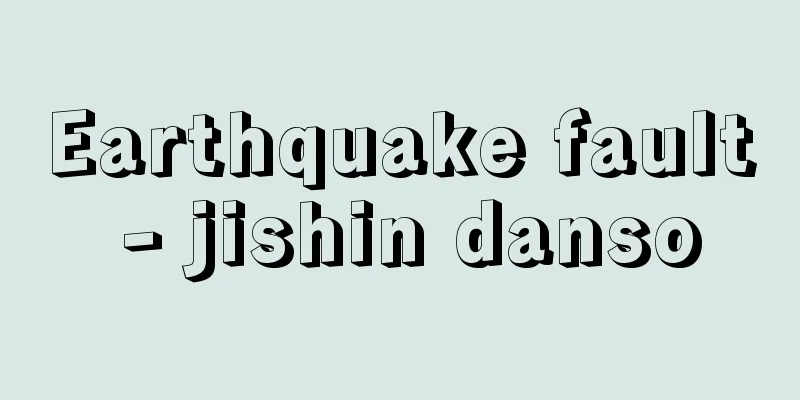Earthquake fault - jishin danso

|
A fault that appears on the earth's surface as a result of an earthquake. Earthquakes occur when faults shift underground, and most earthquake faults are just a part of that fault (called the seismic source fault) that reaches the earth's surface. In addition, there are also secondary faults that appear in bedrock near the earth's surface due to vibrations from a large earthquake or underground shifts. The latter are generally small-scale. Generally speaking, the larger the earthquake, the greater the length of the earthquake fault and the amount of slip. In the case of inland earthquakes in Japan, earthquake faults appear when the earthquake is magnitude 7 to 8, and are 20 to 80 kilometers long and have a slip of about 1 to 8 meters. Notable earthquake faults that have appeared in major earthquakes since the Meiji period include the Neodani Fault (Nobi earthquake, 1891), Sen'ya Fault (Riku earthquake, 1896), Gomura Fault (Kitatango earthquake, 1927), Tanna Fault (Northizu earthquake, 1930), Shikano Fault (Tottori earthquake, 1943), Fukozu Fault (Mikawa earthquake, 1945), Irozaki Fault (Izu Peninsula offshore earthquake, 1974), and Nojima Fault (Hyogo Prefecture Southern Earthquake, 1995). [Matsuda Tokihiko] "Handbook of Earthquake Fault Parameters in Japan" edited by Ryosuke Sato (1989, Kajima Publishing Co., Ltd.) " "Nojima Fault - Photographs and Explanations of the Hyogo-ken Nanbu Earthquake" edited by Takashi Nakata and Atsushi Okada (1999, University of Tokyo Press) [References] | | | | | | | | | | |The source fault of the Nobi earthquake that occurred on October 28, 1891 (Meiji 24) with its epicenter in Neo Village (present-day Neo, Motosu City). The photo shows the Neo Mizudori fault cliff inside the Neoya Earthquake Fault Observation Museum, which opened in 1992 (Heisei 4) for the purpose of preserving and exhibiting the fault. Nationally designated special natural monument Motosu City, Gifu Prefecture ©Motosu City "> Neodani Fault Source: Shogakukan Encyclopedia Nipponica About Encyclopedia Nipponica Information | Legend |
|
地震に伴って地表に現れた断層のこと。地震は地下で断層がずれ動いて発生するが、地震断層の大部分は、その断層(震源断層という)の一部が地表まで達したものである。そのほか、大地震の振動や地下でのずれのために地表付近の岩盤に二次的に生じた断層もある。後者は一般に小規模である。 概して地震の規模が大きいほど、地震断層の長さやずれの量が大きい。日本の内陸の地震の場合、地震断層は地震がマグニチュード7~8のときに出現し、その長さは20~80キロメートル、ずれの量は1~8メートルくらいである。 明治以降の大地震で出現した顕著な地震断層としては、根尾谷(ねおだに)断層(濃尾(のうび)地震、1891年)、千屋(せんや)断層(陸羽(りくう)地震、1896年)、郷村(ごうむら)断層(北丹後地震、1927年)、丹那(たんな)断層(北伊豆地震、1930年)、鹿野(しかの)断層(鳥取地震、1943年)、深溝(ふこうず)断層(三河地震、1945年)、石廊崎(いろうざき)断層(伊豆半島沖地震、1974年)、野島断層(兵庫県南部地震、1995年)などがある。 [松田時彦] 『佐藤良輔編著『日本の地震断層パラメター・ハンドブック』(1989・鹿島出版会)』▽『中田高・岡田篤正編『野島断層――写真と解説 兵庫県南部地震の地震断層』(1999・東京大学出版会)』 [参照項目] | | | | | | | | | | |1891年(明治24)10月28日に根尾村(現本巣市根尾)を震源として発生した濃尾地震の震源断層。写真は断層の保存・展示を目的として1992年(平成4)に開館した根尾谷地震断層観察館内部の根尾水鳥の断層崖。国指定特別天然記念物 岐阜県本巣市©本巣市"> 根尾谷断層 出典 小学館 日本大百科全書(ニッポニカ)日本大百科全書(ニッポニカ)について 情報 | 凡例 |
Recommend
Paeonia japonica (English spelling)
…[Hiroshi Aramata]. … *Some of the terminology th...
Mathieu, G.
...Originally, it was derived from Pollock, who w...
Alessandria - Aresandria (English spelling) Alessandria
Alessandria is the capital of the province of Ale...
Ladder - ladder
A tool for climbing to high places. Depending on ...
Kanesue Imadegawa
Year of death: Rekio 2/Engen 4.1.16 (1339.2.25) Ye...
by-election
A by-election is an election held to fill a vacan...
Summer Festival Naniwa Kagami - Natsumatsuri Naniwa Kagami
Joruri Gidayu-bushi. Sewamono (domestic drama). N...
Ward chief - kucho
The heads of the 23 special wards of Tokyo and war...
Alveolar oxygenator - alveolar oxygenator
...When performing surgery on the heart or large ...
Giant river snail - Okawanina
...It is found in the southern part of Hokkaido t...
Galactic rotation constant - ginga kaiten teisou
…A constant introduced by Dutch astronomer J. H. ...
Kyoyama Koen
1876-1928 (Meiji 9-Showa 3) A rakugo performer. Hi...
Sancerre (English spelling)
A town on the upper Loire River in the Cher depart...
Declaration of Indulgence
In 1689, after the Glorious Revolution, the Religi...
Front line - Zensen (English spelling) front
The boundary between a dense (cold) air mass and ...









